Healthcare professionals, whether in nursing, physician care, allied health, or administration, often face intense competition when applying for new roles. Hiring managers evaluate hundreds of resumes, and applicant tracking systems (ATS) filter out those that fail to meet formatting, keyword, or content requirements.
This guide equips professionals with the tools to create documents that align with industry standards and capture employer attention. It provides detailed healthcare resume examples and writing guides, including writing best practices, formatting techniques, and ways to highlight certifications and measurable outcomes.

Clarification on Resumes vs. Curriculum Vitae in Healthcare
In the healthcare field, it’s essential to distinguish between a resume and a curriculum vitae (CV), as they serve different purposes and are suited for different types of professionals.
- Resumes are typically used by healthcare professionals such as nurses, allied health workers, and administrative staff. These documents are concise and focus on relevant skills, experiences, and achievements tailored to specific job applications.
- Curriculum Vitaes (CVs), on the other hand, are more comprehensive documents and often longer than a resume. It is generally used by specialists in medical professions, such as physicians and surgeons. A CV includes detailed information about one’s academic background, research, publications, certifications, and professional affiliations.
By understanding these distinctions, healthcare job seekers can better prepare their application materials to align with the expectations of hiring managers in their specific fields. his article focuses on providing healthcare resume examples and writing guide to assist candidates in crafting standout resumes.
The Importance of a Strong Healthcare Resume
In the United States healthcare system, which employs more than 20 million workers according to the U.S. Bureau of Labor Statistics, a strong resume is crucial, not only for securing interviews and job offers, but also for the following reasons:
- Gateway to Opportunities: Resumes serve as the first impression for employers, making it essential to present qualifications effectively. It is crucial for candidates to present their qualifications in a clear and impactful manner.
- Highlighting Key Attributes: Employers seek professionals who not only meet clinical requirements but also demonstrate leadership, adaptability, and compliance with patient care standards. A strong healthcare resume should underline these attributes through a mix of clear formatting, tailored summaries, and quantifiable results.
- Emphasizing Measurable Outcomes: Healthcare employers often prioritize resumes that show measurable patient outcomes, leadership in interdisciplinary teams, and the ability to manage complex regulatory environments. In practice, this means candidates who provide real statistics stand out far more than those who rely on vague claims.
By crafting a strong healthcare resume, applicants could position themselves as valuable candidate ready to meet the demands of the healthcare industry.
Key Sections of a Healthcare Resume
A healthcare resume requires carefully constructed sections that balance both ATS readability and human review appeal. This healthcare resume examples and writing guide emphasize the including following sections, as they form the foundation of a well-structured healthcare resume tailored to U.S. job markets:
- Contact Information: Include full name, current credentials (RN, MD, etc.), phone number, professional email, city, and state. LinkedIn profiles should be hyperlinked if complete and relevant.
- Professional Summary: A concise, achievement-driven statement tailored to each job posting. Should emphasize career highlights and specialties.
- Licenses and Certifications: Featuring state board approvals, CPR certifications, advanced practice credentials, or industry-required certificates.
- Experience: Organized in reverse chronological order with bullet points beginning with strong action verbs and quantifiable details.
- Education: Degrees, institutions, and dates. Medical professionals may include residencies or fellowships.
- Skills: Both clinical and soft skills, structured around the keywords listed in job descriptions.
- Professional Affiliations: Memberships with organizations such as the American Nurses Association or American College of Healthcare Executives.
Ensuring these sections are present and strategically arranged allows applicants to align with healthcare hiring norms while also maximizing ATS scoring potential. A missing license, poorly formatted credential, or underdeveloped skill section can disqualify even qualified candidates.
Best Practices for ATS-Optimized Healthcare Resumes
Healthcare employers rely on applicant tracking systems to streamline hiring. These platforms scan resumes for content, format, and targeted keywords. To make your resume compatible with ATS and avoid rejection, follow the best practices outlined in this healthcare resume examples and writing guide:
- Use Standard Headings: ATS algorithms favor traditional labels such as “Experience” rather than creative alternatives like “Career Journey.”
- Choose ATS-Friendly Formats: Avoid images, tables for text, and decorative graphics. Use Word or PDF formats that accept text scans.
- Incorporate Job-Specific Keywords: Pull terminology directly from job postings, particularly regarding specialties like “oncology patient care,” “HIPAA compliance,” or “Epic EHR systems.”
- Leverage Bullet Points: Strong statements beginning with action verbs—such as coordinated, implemented, improved—boost readability while pleasing ATS systems.
- Balance Hard and Soft Skills: Hard skills such as “phlebotomy” pair effectively with soft skills such as “patient-centered communication.”
Ensuring ATS compatibility does not mean sacrificing human readability. Recruiters often see resumes after initial filters, and they favor clean layouts and concise yet persuasive details. The strongest documents meet both technical and professional expectations.
Modern Healthcare Resume Examples and Writing Guide
Different healthcare roles demand industry-specific resume strategies. A resume for a nurse differs significantly from one tailored for a healthcare administrator or a pharmacist. Below are examples and tips broken down by field, as detailed in this healthcare resume examples and writing guide:
- Nurses: Highlight patient ratios, specialized units (ICU, ER, pediatrics), and technology experience with monitoring systems. Include state licenses upfront.
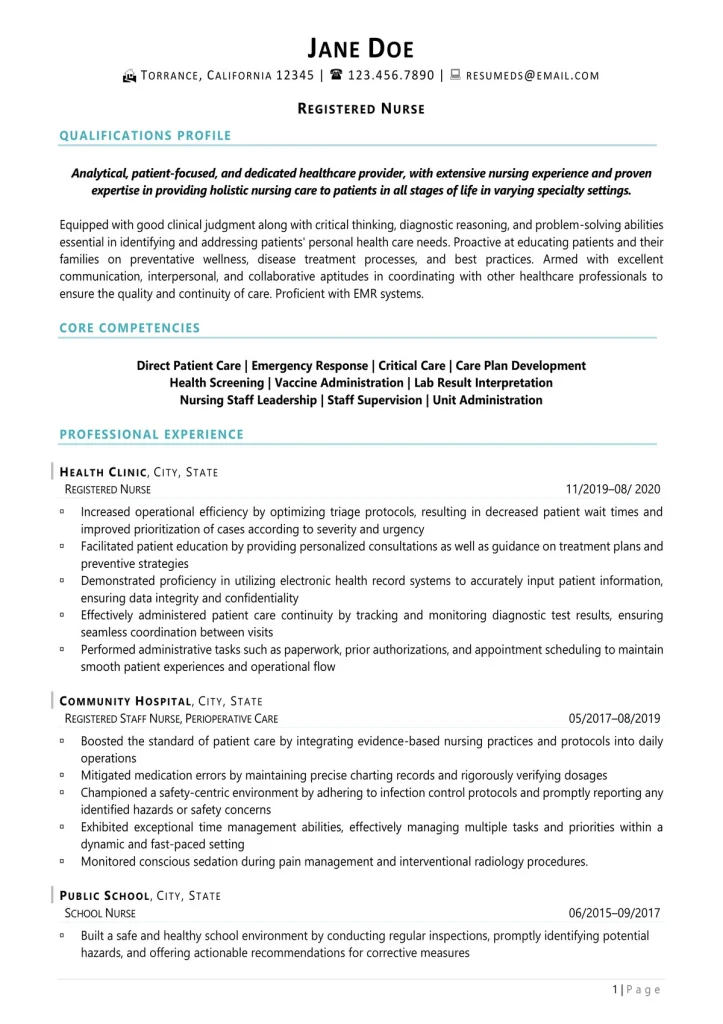
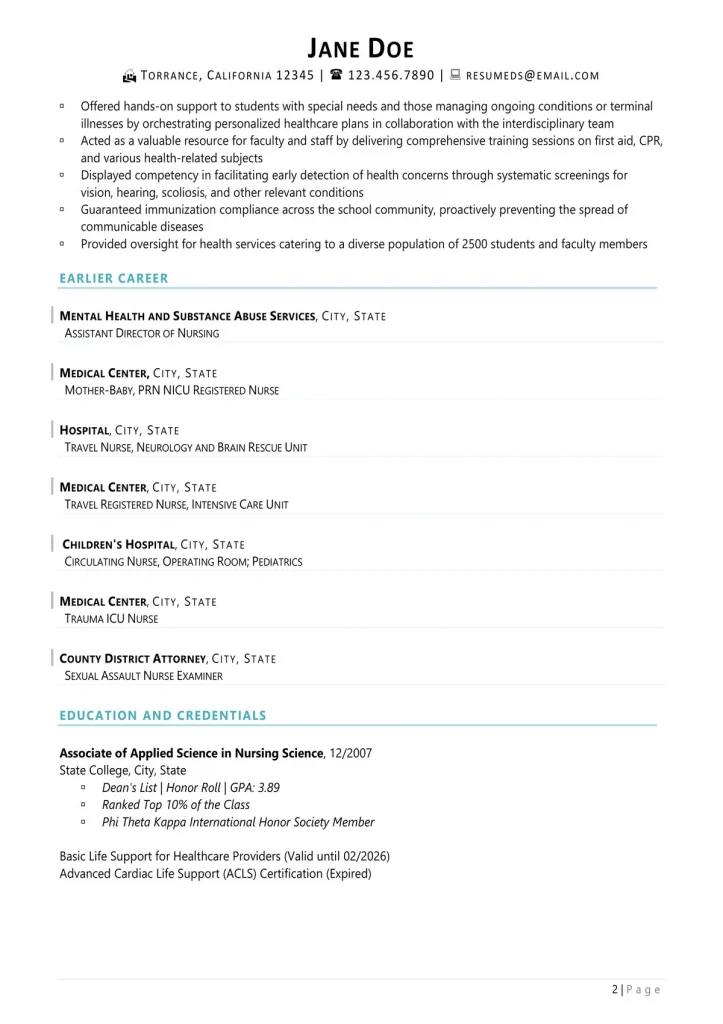
- Paramedic: Showcase emergency response skills, advanced life support certifications, and experience in high-pressure environments. Include specific examples of critical situations handled.

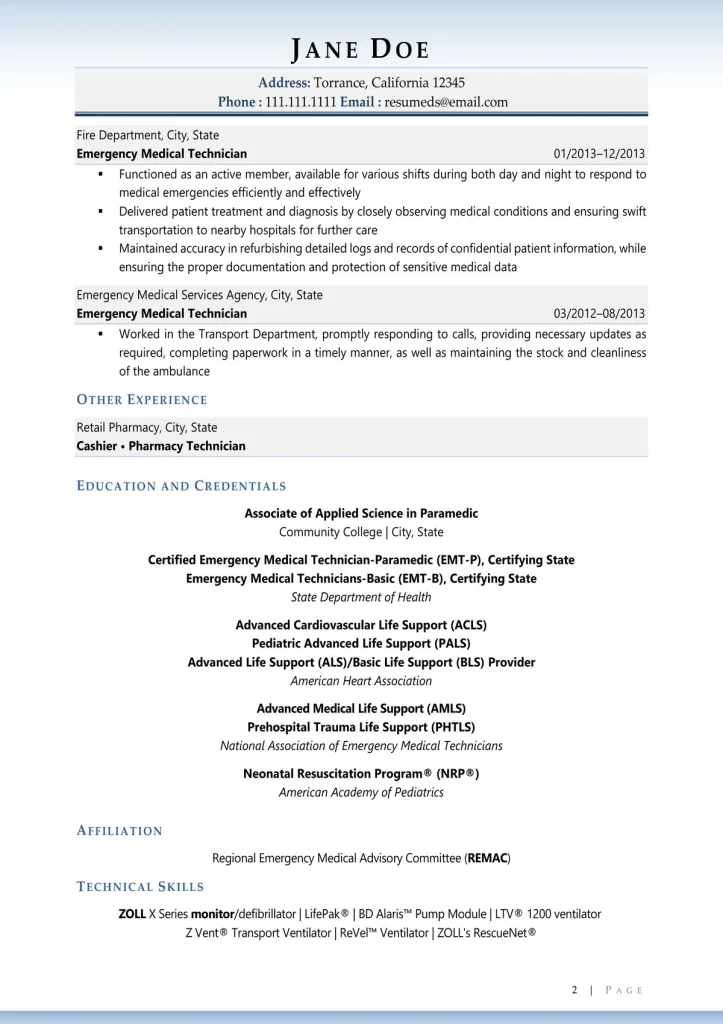
- Medical Assistants: Emphasize administrative and clinical hybrid skills, patient intake, and use of EMR systems.


- Pharmacists: Include regulatory compliance experience, immunization certifications, and community education initiatives.
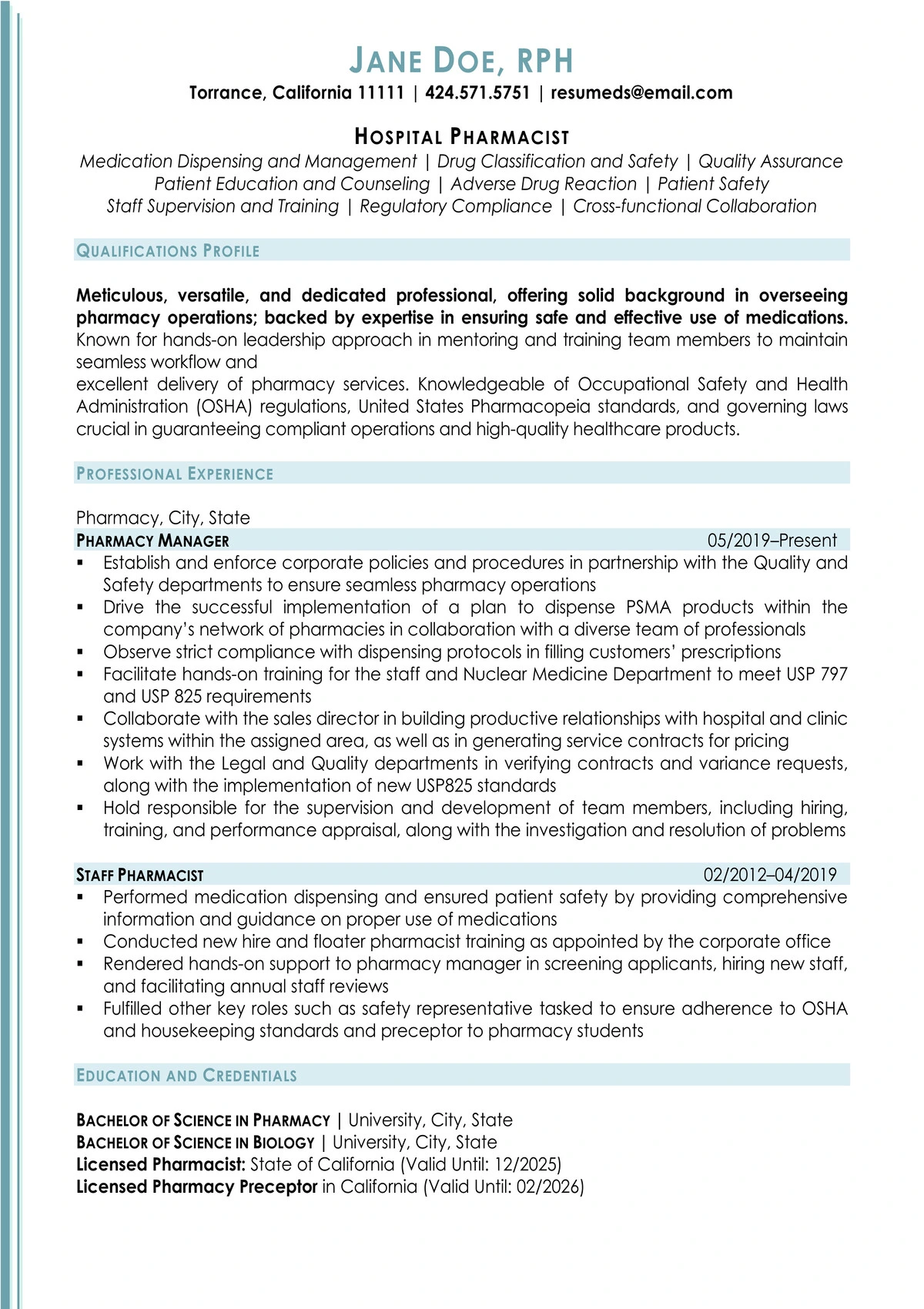
- Administrative Healthcare Staff: Emphasize ability to manage schedules, coordinate appointments, and maintain efficient office operations. Mention any tools or software (like EMR systems) proficient candidates used that enhance workflow efficiency..

- Allied Health Professionals: For fields like physical therapy or radiology, highlight clinical expertise, patient throughput efficiency, and knowledge of specialized equipment.
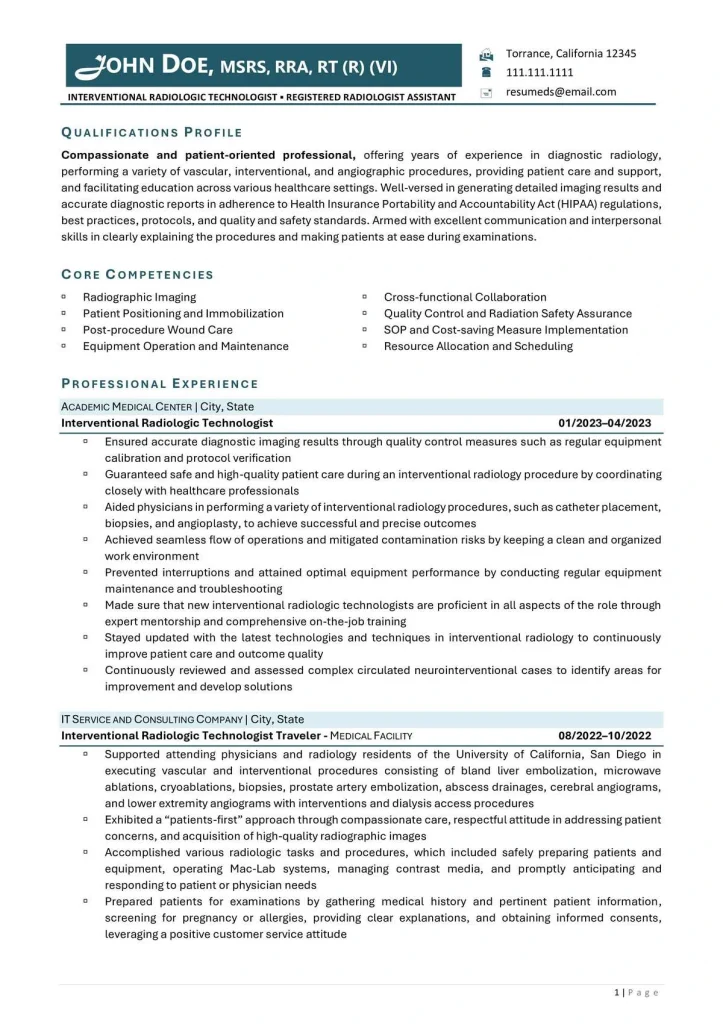

Each profession benefits from emphasizing credentials, measurable achievements, and patient-centered results. While the overall structure remains consistent, tailoring industry-specific language ensures alignment with recruiter expectations.
Skills to Showcase on Healthcare Resumes
Healthcare resumes must emphasize both technical and interpersonal skills. Employers require strong clinical competence alongside the capacity to communicate and collaborate across care teams.
These are examples of critical skills valued by employers, as highlighted in this healthcare resume examples and writing guide:
| Category | Examples |
|---|---|
| Clinical | Patient assessment, wound care, IV administration, radiology equipment operation |
| Technical | Electronic health record (EHR) systems, telemedicine platforms, laboratory software |
| Compliance | HIPAA adherence, OSHA regulations, infection control |
| Leadership | Team management, staff training, process improvement |
| Soft Skills | Communication, empathy, conflict resolution, adaptability |
Choosing the right combination of these skills ensures that resumes align with both technical ATS scans and recruiter expectations. Candidates should always customize skill sections to individual job postings for maximum effectiveness.
Formatting Guidelines for Medical Resumes
Formatting determines whether resumes appear polished and professional. Following clean, professional standards ensures positive first impressions. This healthcare resume examples and writing guide emphasizes:
- Length: One page for entry-level professionals, two pages for experienced clinicians and executives.
- Font: Calibri, Arial, or Times New Roman in sizes 10–12 for readability.
- Spacing: Consistent, with 0.5–1-inch margins. Adequate white space increases readability.
- Bullet Points: Use 4–6 bullets per role, each starting with an action verb.
- Consistency: Ensure uniform tense, punctuation, and alignment across sections.
Resumes that apply minimalistic formatting while keeping content achievement-driven are most effective for healthcare applications. Clarity and precision consistently outperform design-heavy templates.
Strengthen Healthcare Resumes With Metrics
Numbers provide credibility and context to accomplishments. Recruiters and medical directors value evidence of impact. Metrics establish verifiable success, as discussed in this healthcare resume examples and writing guide:
- Patient Outcomes: “Improved discharge compliance by 15% through patient education programs.”
- Operational Efficiency: “Lowered supply costs by 9% through vendor negotiations.”
- Staff Engagement: “Trained 25+ nurses in updated EHR systems with 100% adoption.”
- Quality & Safety: “Maintained zero medical error incidents for two consecutive years.”
- Revenue Impact: “Increased department billing accuracy, generating $250K additional revenue.”
Quantification strengthens credibility and secures attention during competitive evaluations. Professionals across all healthcare specialties should integrate performance-based evidence.

Elevate Your Career Success With Professional Help
A powerful resume can determine how healthcare professionals stand out in a competitive job market. By highlighting clinical expertise, certifications, and measurable outcomes, candidates can open doors to new opportunities. Many achieve this with healthcare resume experts that ensure ATS compliance and tailored storytelling for the medical field.
Frequently Asked Questions
What is the best format for a healthcare resume?
The reverse chronological format is preferred for healthcare resumes, as it clearly highlights recent clinical experience and professional progression. It makes it easier for hiring managers to verify current licensing and recent patient care roles.
How long should a medical resume be?
Entry-level healthcare professionals should aim for a one-page resume, while experienced clinicians, physicians, and executives are expected to provide two-page resumes that cover extensive credentials, fellowships, and leadership experience.
Should healthcare resumes include certifications?
Yes. Certifications such as BLS, ACLS, PALS, or specialized credentials must be clearly listed near the top of the resume, as many healthcare facilities require them for compliance and credentialing.
What keywords are important for healthcare resumes?
Essential keywords include HIPAA compliance, patient care, EHR/EMR systems, interdisciplinary collaboration, quality assurance, and specific departmental specialties such as oncology, cardiology, or pediatrics.
Do healthcare resumes differ from CVs?
Yes. A resume is job-specific, concise, and geared toward ATS filtering, typically 1–2 pages long. A CV is more extensive and often spans several pages, covering education, research, publications, and academic or fellowship history. Physicians often use CVs rather than resumes.
{
“@context”:”https://schema.org”,
“@type”:”FAQPage”,
“mainEntity”:[
{
“@type”:”Question”,
“name”:”What is the best format for a healthcare resume?”,
“acceptedAnswer”:{
“@type”:”Answer”,
“text”:”The reverse chronological format is preferred for healthcare resumes, as it clearly highlights recent clinical experience and professional progression.”
}
},
{
“@type”:”Question”,
“name”:”How long should a medical resume be?”,
“acceptedAnswer”:{
“@type”:”Answer”,
“text”:”Entry-level healthcare professionals should aim for a one-page resume, while experienced clinicians, physicians, and executives are expected to provide two-page resumes that cover extensive credentials.”}
},
{
“@type”:”Question”,
“name”:”Should healthcare resumes include certifications?”,
“acceptedAnswer”:{
“@type”:”Answer”,
“text”:”Yes. Certifications such as BLS, ACLS, PALS, or specialized credentials must be clearly listed near the top of the resume, as many healthcare facilities require them.”}
},
{
“@type”:”Question”,
“name”:”What keywords are important for healthcare resumes?”,
“acceptedAnswer”:{
“@type”:”Answer”,
“text”:”Essential keywords include HIPAA compliance, patient care, EHR/EMR systems, interdisciplinary collaboration, quality assurance, and departmental specialties.”}
},
{
“@type”:”Question”,
“name”:”Do healthcare resumes differ from CVs?”,
“acceptedAnswer”:{
“@type”:”Answer”,
“text”:”Yes. A resume is concise, job-specific, and ATS friendly, typically 1–2 pages long. A CV is more extensive and covers education, research, publications, and academic history, often used by physicians.”}
}
]
}
